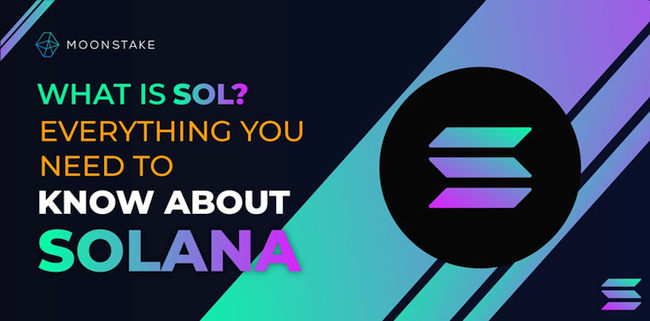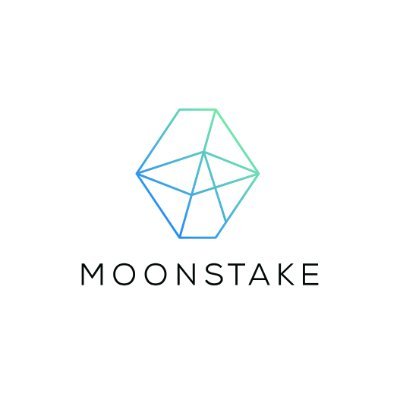Welcome to this edition of 101 article exploring one of the staking coins on Moonstake. This time, we’ll be looking at Solana and its native coin SOL, which has grown rapidly since its inception just a few years ago and is now one of the most popular cryptocurrencies on the market, referred to by many crypto experts as one of the Ethereum killers.

What Makes Solana Unique?
Originally launched in 2020, Solana is a layer-1 blockchain that focuses on scalability, speed, cost minimization, and energy-efficiency. Solana’s innovative infrastructure maintains a single global state between different ecosystems as the network scales, eliminating the need to rely on fragmented layer-2 systems or sharded chains.
Most notably, Solana is committed to providing a fast and low-cost experience to both users and developers. It promises an admirable sub 0.01 USD transaction fee and merely 0.001 seconds in transaction processing time. Even after the transition to Proof of Stake (PoS), transaction cost and speed remains a concern amongst Ethereum users. Therefore, Ethereum rivals are focused on solving these issues, and Solana stands out as one of the most competitive alternatives to the world’s second largest blockchain.
For the consensus algorithm, Solana implements an innovative hybrid model of PoS that combines a unique timestamp-based Proof of History (PoH) algorithm with a high-speed synchronization system. This allows transactions to be validated much faster, reducing the load of the Solana network and increasing its bandwidth, in other words, scalability.
How Did Solana Become Popular?
Solana saw a meteoric rise in value in fall 2021 due to a boom in NFT sales and widespread awareness of its utilities, most notably after the launch of the Wormhole 2.0 update that heightened interoperability with other high-value blockchains. The project also supports an array of DeFi platforms as well as NFT marketplaces.
Thanks to the network’s high efficiency in speed, costs, and capacity, as well as an enticing staking ecosystem, Solana has become one of the most popular blockchains for DApp developers and staking users. It now sits in the ranking of the top 10 cryptocurrencies in terms of market capitalization.
Solana’s Technical Milestones and Why Moonstake Supports SOL
At Moonstake, we work to support the most demanded coins on the market. Here are some key milestones of Solana so far:
- From 2018 – 2019, Solana raised over 20 million for the SOL token sale to investors, despite the relatively bearish market situation after the 2017 crypto bubble.
- During the NFT craze in 2021, Solana was home to the popular Degenerate Ape Academy NFT, a collection of 10,000 apes which sold out in less than 10 minutes.
- By August 2021, over 400 projects have been built on Solana, just a little over a year since its launch. Many DeFi projects are building on Solana to take advantage of its powerful and cost-effective infrastructure.
- In September 2021, Solana launched its Wormhole 2.0 protocol that enabled the transfer of digital assets between ERC-20 and SPL blockchains. This is believed to be one of the main factors that contributed to the rise of Solana.
- Currently, Solana has over 3,400 validators to help secure and decentralize the network and is currently competing with other emerging Ethereum competitors such as Polygon and Polkadot. It has been stably sitting at rank #10 on Coinmarketcap.
We can see that SOL is a high-demand coin and Solana network is an esteemed blockchain project with active, constant development and support both from its creators and lively developer community. This makes SOL a great and strategic addition to the lineup of PoS coins supported by Moonstake and we are working hard to bring SOL staking to you very soon.
How SOL Staking Work
On Solana, tokens in a stake account must be delegated to a validator. A single stake account can only be delegated to a single validator at any time, so if you want to delegate to different validators you will need to split your tokens between multiple stake accounts.
To stake SOL tokens, you must use a wallet that supports staking. SOL tokens in your wallet must first be moved into a stake account. You can create as many stake accounts as you like, and deposit as much or as little SOL into each stake account as you want. Each new stake account has a unique address, and a single wallet can manage or “authorize” many different stake accounts.
How To Get Rewards for SOL Staking
SOL staking has historically yielded around 6% APY, though as usual this number will fluctuate depending on network activity. Staking rewards are computed and issued once per epoch which is approximately 2 days. However, to begin earning rewards, you must first wait for two epochs (around 4 days).
Rewards accrued in a given epoch are issued to all validators and delegators in the first block of the following epoch. Rewards are issued once per epoch and deposited into the stake account that earned them.
Stake rewards are automatically re-delegated as active stake. If the rewards due to a validator or one of their stakes is less than one lamport for a given epoch, reward issuance is deferred until the next epoch in which both would receive at least one lamport. A lamport is a fractional native token with the value of 0.000000001 SOL.
How SOL Unstaking Works
Tokens can only be withdrawn from a stake account when they are not currently delegated. When a stake account is first un-delegated, it is considered “deactivating” or “cooling down”. Tokens may not be withdrawn from the account until some or all of them have finished deactivating and are considered “inactive” and therefore no longer earning any potential staking rewards.
Once the tokens in a stake account are inactive, they can be withdrawn back to your main wallet address or to another address immediately. Tokens in a stake account with a lockup may not be withdrawn until the lockup expires, regardless of the delegation state of that account. Once the lockup expires, undelegated tokens may be withdrawn immediately. There is no action required by the account holder to specifically unlock the account.
Reference:
https://solana.com/
https://docs.solana.com/
https://solana.com/news/validator-health-report-august-2022
About Moonstake
Moonstake is the world’s leading staking service provider that develops and operates decentralized wallet services for businesses and individuals. Since its launch in April 2020, Moonstake has partnered with 27 leading platform providers, including Cardano’s constituent Emurgo, developer of the Polkadot-connected blockchain Astar Network Stake Technologies, and the TRON Network with over 50 million users. In May 2021, Moonstake further enhanced its corporate credibility by becoming a wholly owned subsidiary of OIO Holdings Limited, a company listed on the Singapore Stock Exchange. Using blockchain technology, Moonstake aims to progress toward a world where anyone can easily make use of highly secure and reliable digital asset management tools. https://www.moonstake.io/
